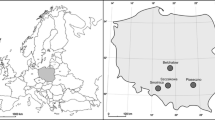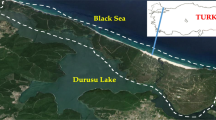Abstract
The growth of Scots pine and its suitability for afforestation of post-mining landscapes in Northeast Estonia were assessed in comparative analytical studies by using morphological parameters and mineral nutrition characteristics. The growth and nutrient uptake of Scots pine growing on post-mining substrate were compared with the characteristics of pines of the same age (22–23 years) in a Calluna forest site type predominant in North Estonia in similar climatic zone. Results of the analyses of soil upper layers showed that the concentration of N and P in soil did not differ between the opencast spoil and Calluna site, but significantly higher pH of soil and concentrations of K, Ca, and Mg were found in mine spoil. The concentrations of K and Mg in needles were significantly higher in the post-mining area, but the concentrations of N, P, and Ca did not differ significantly. Comparison of the needle nutrient concentration with the standard for optimum concentrations revealed P deficit in the post-mining area and P and K deficit in the Calluna site. Scots pine formed longer and thinner needles and shoots in the post-mining substrate than in the Calluna site. It was assumed that in the post-mining area the growth of pines is predominantly dependent on K and Ca concentrations in their tissues as the biomass of needles was strongly correlated with the K/Ca ratio, whereas the biomass in the Calluna site was correlated with the N/P ratio. The height and diameter of trees were significantly larger in the post-mining area.
Similar content being viewed by others
References
Baumann, K., Rumpelt, A., Schneider, B. U., Marschner, P., & Hüttl, R. F. (2006). Seedling biomass and element content of Pinus sylvestris and Pinus nigra grown in sandy substrates with lignite. Geoderma, 136, 573–578. doi:10.1016/j.geoderma.2006.04.013.
Bradshaw, A. D. (1983). The reconstruction of ecosystems. Presidential address to the British Ecological Society, December 1982. Journal of Applied Ecology, 20(1), 1–17. doi:10.2307/2403372.
Brække, F. H., & Salih, N. (2002). Reliability of foliar analysis of Norway spruce stands in a Nordic gradient. Silva Fennica, 36(2), 489–504.
Directive of Forest Management (2006). Regulation of Minister of Environment nr. 77, 14.12.2006. RTL, 91, 1684 (in Estonian).
Ingestad, T. (1979). Mineral nutrient requirements of Pinus silvestris and Picea abies seedlings. Physiologia Plantarum, 45(4), 373–380. doi:10.1111/j.1399-3054.1979.tb02599.x.
Ingestad, T. (1987). New concepts on soil fertility and plant nutrition as illustrated by research on forest trees and stands. Geoderma, 40(3–4), 237–252. doi:10.1016/0016-7061(87)90035-8.
Ingestad, T., & Ågren, G. I. (1988). Nutrient uptake and allocation at steady-state nutrition. Physiologia Plantarum, 72(3), 450–459. doi:10.1111/j.1399-3054.1988.tb09150.x.
Kaar, E. (2002). Coniferous trees on exhausted oil shale opencast mines. Metsanduslikud Uurimused, 36, 120–125.
Kaar, E., & Raid, L. (1996). Afforestation of Estonian oil shale opencast sites and management of stands planted on recultivated sites. Final Report of Grant No. 366. MS at Estonian Naturalists’ Society. Tartu (in Estonian).
Kaar, E., & Tomberg, E. (2006). Recultivation of the quarry spoil. In I. Valgma (Ed.), 90 Years of oil shale mining in Estonia. Proceedings of the conference of Estonian Miners 2006 by Estonian Mining Society (pp. 78–83). Tallinn: Tallinn University of Technology (in Estonian).
Kärblane, H. (Comp.) (1996). A manual of plant nutrition and fertilization. Tallinn: Ministry of Agriculture (in Estonian).
Keren, R., Gast, R. G., & Bar-Yosef, B. (1981). pH-dependent boron adsorption by Na-montmorillonite. Soil Science Society of America Journal, 45(1), 45–48.
Koerselman, W., & Meuleman, A. F. M. (1996). The vegetation N:P ratio: A new tool to detect the nature of nutrient limitation. Journal of Applied Ecology, 33(6), 1441–1450. doi:10.2307/2404783.
Kupka, I., & Dimitrovský, K. (2006). Silvicultural assessment of reforestation under specific spoil bank conditions. Journal of Forest Science, 52(9), 410–416.
Kuznetsova, T. (2004). State of conifers on exhausted oil shale opencast mines. M.Sc. thesis, Estonian Agricultural University, Faculty of Forestry. Tartu (in Estonian with summary in English).
Kuznetsova, T., & Mandre, M. (2005). Mineral composition of lodgepole pine (Pinus contorta var. latifolia Engelm.) on exhausted oil shale opencast mines. Metsanduslikud Uurimused, 42, 106–115.
Kuznetsova, T., & Mandre, M. (2006). Chemical and morphological indication of the state of lodgepole pine and Scots pine in restored oil shale opencast mining areas in Estonia. Oil Shale, 23(4), 366–384.
Kuznetsova, T., & Pärn, H. (2004). Some results of the afforestation of closed oil shale opencasts with exotic conifers. Oil Shale, 21(4), 321–331.
Limstrom, G. A. (1960). Forestation of strip-mined land in the Central States. USDA Agriculture Handbook, 166. Washington, DC: U.S. Government Printing Office.
Lõhmus, K., Truu, J., Truu, M., Kaar, E., Ostonen, I., Alama, S., et al. (2006). Black alder as a promising deciduous species for the reclaiming of oil shale mining areas. In C. A. Brebbia, & Ü. Mander (Eds.), Brownfields III. Prevention, assessment, rehabilitation and development of Brownfield Sites. WIT transactions on ecology and the environment (Vol. 94, pp. 87–97). Southampton, Boston: WIT.
Mandre, M. (1995). Changes in the nutrient composition of trees. In M. Mandre (Ed.), Dust pollution and forest ecosystems. A study of conifers in an alkalized environment. Publication 3 (pp. 44–65). Tallinn: Institute of Ecology.
Mandre, M., & Kuznetsova, T. (2004). Conditions for mineral nutrition of conifers on reclaimed oil shale mine sites. Metsanduslikud Uurimused, 41, 17–26.
Mandre, M., Pärn, H., & Ots, K. (2006). Short-term effects of wood ash on the soil and the lignin concentration and growth of Pinus sylvestris L. Forest Ecology and Management, 223(1–3), 349–357. doi:10.1016/j.foreco.2005.11.017.
Mandre, M., & Tullus, H. (2002). Partitioning of nutrients and biomass in Scots pine canopy. Proceedings of the Estonian Academy of Sciences. Biology, Ecology, 51(3), 163–172.
Marschner, H. (2002). Mineral nutrition of higher plants. London: Academic.
Miidla, H. (1989). Biochemistry of lignin formation. In Publications in plant physiology and plant biochemistry, 5. The formation of lignin in wheat plants and its connection with mineral nutrition. Acta et commentationes Universitatis Tartuensis (Vol. 845, pp. 11–23). Tartu: Tartu Riiklik Ülikool.
Orlov, A. Y., & Koshel’kov, S. P. (1971). Soil ecology of pine. Moscow: Nauka (in Russian).
Ots, K. (2002). Impact of air pollution on the growth of conifers in the industrial region of Northeast Estonia (222 pp.). DSc thesis. Tartu: Estonian Agricultural University.
Pensa, M., & Sellin, A. (2002). Needle longevity of Scots pine in relation to foliar nitrogen content, specific leaf area, and shoot growth in different forest types. Canadian Journal of Forest Research, 32(7), 1225–1231. doi:10.1139/x02-044.
Piha, M. I., Vallack, H. W., Reeler, B. M., & Michael, N. (1995). A low input approach to vegetation establishment on mine and coal ash wastes in semi-arid regions. I. Tin mine tailings in Zimbabwe. Journal of Applied Ecology, 32(2), 372–381. doi:10.2307/2405103.
Raid, L. (1972). Über den Wasserhaushalt der obrigen Bodenschichten der eingeebneten Kippen. Metsanduslikud Uurimused, 9, 159–171 (in Estonian with summary in German).
Raid, L. (1979). Über die Düngungsbedürftigkeit des Kiefers auf Grund von Vegetationsversuchen auf den Böden einiger Standorttypen. Metsanduslikud Uurimused, 14, 59–76 (in Estonian with summary in German).
Raid, L. (1996). Die Wirkung der einmaligen und wiederholten Düngung auf die Ernährung der Nadelholzsämlinge. Metsanduslikud Uurimused, 27, 92–101 (in Estonian with summary in German).
Raid, L., & Vaus, M. (1971). Soils of the graded overburden dumps. In E. Kaar, L. Lainoja, H. Luik, L. Raid, & M. Vaus (Eds.), Reclamation of the oil shale mines (pp. 56–70). Tallinn: Valgus (in Estonian).
Raitio, H. (1990). Decline of young Scots pines in a dry heath forest. Acta Universitatis Ouluensis, A, 216, 76.
Reintam, L. (2001). Changes in the texture and exchange properties of skeletal quarry detritus under forest during thirty years. Proceedings of the Estonian Academy of Sciences. Biology, Ecology, 50(1), 5–13.
Reintam, L., & Kaar, E. (1999). Development of soils on calcareous quarry detritus of open-pit oil shale mining during three decades. Proceedings of the Estonian Academy of Sciences. Biology, Ecology, 48(4), 251–266.
Reintam, L., Kaar, E., & Rooma, I. (2002). Development of soil organic matter under pine on quarry detritus of open-cast oil-shale mining. Forest Ecology and Management, 171(1–2), 191–198. doi:10.1016/S0378-1127(02)00472-3.
Ruzicka, J., & Hansen, E. H. (1981). Flow injection analysis. New York: Wiley.
Thompson, B. E. (1985). Seedling morphological evaluation—What you can tell by looking. In M. L. Duryea (Ed.), Evaluating seedling quality: Principles, procedures, and predictive abilities of major tests (pp. 59–71). Corvallis: Forest Research Laboratory, Oregon State University.
Author information
Authors and Affiliations
Corresponding author
Rights and permissions
About this article
Cite this article
Kuznetsova, T., Mandre, M., Klõšeiko, J. et al. A comparison of the growth of Scots pine (Pinus sylvestris L.) in a reclaimed oil shale post-mining area and in a Calluna site in Estonia. Environ Monit Assess 166, 257–265 (2010). https://doi.org/10.1007/s10661-009-0999-1
Received:
Accepted:
Published:
Issue Date:
DOI: https://doi.org/10.1007/s10661-009-0999-1




